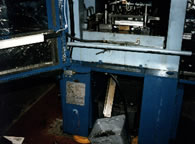Anti-vibration treatment of high-speed presses
The problem

High-speed, strip-fed punch presses are a common source of noise. In one company, a press used for stamping electrical trip-catch components caused A-weighted levels of 101 dB when running at 271 strokes per minute.
The major noise radiating areas were the legs on which the press frame sat. As these were welded, they were prone to transmit vibration with little or no damping.
The solution
To reduce the transmission of mechanical vibration from the press frame to its supporting legs, it was decided to insert 6 mm thick composite pads between them. The area and arrangement of the isolating material was selected to provide a resonant frequency of 65 Hz on both legs, below both the frequency of all major structural resonance and the frequency of maximum acoustic radiation. Care was taken to ensure that there was no mechanical link between the press frame and legs.
Other work was carried out to reduce noise radiated by the press manufacturer's acoustic guards which had been subjected to the same vibration. This was achieved by applying a layer of self-adhesive damping sheet to the sheet metal surfaces of the guards.
The cost
£50 for materials. (1995)
The result
A noise reduction of about 9 dB. The treatment had no effect on machine operation, access or maintenance.
Source
Consultants were Industrial Noise and Vibration Centre.